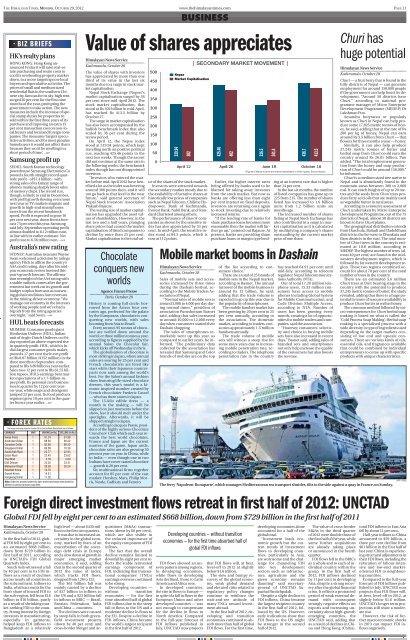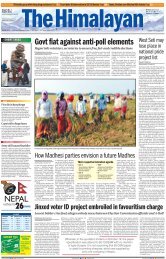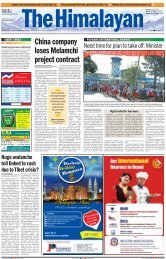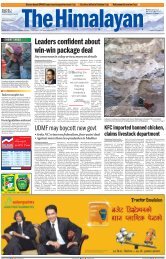Forget CA revival, Prez tells parties
Forget CA revival, Prez tells parties
Forget CA revival, Prez tells parties
Create successful ePaper yourself
Turn your PDF publications into a flip-book with our unique Google optimized e-Paper software.
THE HIMALAYAN TIMES, MONDAY, OCTOBER 29, 2012 www.thehimalayantimes.com<br />
BUSINESS<br />
• BIZ BRIEFS<br />
HK’s realty plans<br />
HONG KONG: Hong Kong announced<br />
Friday it will raise real-estate<br />
purchasing and resale costs to<br />
cool its overheating property market<br />
down, in a move targeting non-local<br />
buyers and speculative activities. The<br />
prices of small and medium sized<br />
residential flats in the southern Chinese<br />
city, famous for its sky-high rent,<br />
surged 20 per cent for the first nine<br />
months of the year, prompting the<br />
government to take action. The new<br />
measures include the increase of special<br />
stamp duties for properties resold<br />
within the first three years of its<br />
purchase and imposing an extra 15<br />
per cent transaction cost on non-local<br />
buyers and local and foreign companies.<br />
The measures ‘targets speculative<br />
activities, and for most genuine<br />
homebuyers it would not affect them<br />
because they won’t be reselling in a<br />
short period of time’. —AFP<br />
Samsung profit up<br />
SEOUL: South Korean technology<br />
powerhouse Samsung Electronics Co<br />
posted a fourth straight record quarterly<br />
profit - of $7.4 billion - with<br />
strong sales of its Galaxy range of<br />
phones masking sharply lower sales<br />
of memory chips. The record run,<br />
though, is likely to end in December,<br />
with profit growth slowing even more<br />
next year as TV markets stagnate and<br />
growth in high-end smartphones<br />
eases from the recent breakneck<br />
speed. Profit is expected to grow 16<br />
per cent next year, down from a forecast<br />
73 per cent this year. Samsung<br />
said July-September operating profit<br />
almost doubled to 8.12 trillion won,<br />
in line with its earlier estimate. Net<br />
profit rose to 6.56 trillion won. —AFP<br />
Australia’s new rating<br />
SYDNEY: Australian treasurer Wayne<br />
Swan welcomed a decision by ratings<br />
agency Fitch to affirm the country’s<br />
AAA credit rating, days after his midyear<br />
economic review lowered this<br />
year’s growth forecast. The affirmation<br />
overnight of the AAA rating with<br />
a stable outlook comes after the government<br />
last week cut its growth and<br />
budget surplus forecasts as worsening<br />
global conditions hurt revenues<br />
in the mining-driven economy. “We<br />
manage our economy in the interests<br />
of working people and we’ve had a<br />
big tick from the rating agencies<br />
overnight,” said Swan. —AFP<br />
HUL beats forecasts<br />
MUMBAI: Consumer goods giant<br />
Hindustan Unilever (HUL), Indian<br />
unit of Anglo-Dutch Unilever, on Friday<br />
reported an above-expected rise<br />
in quarterly profit. HUL, which is India’s<br />
largest consumer goods maker,<br />
posted a 17 per cent rise in net profit<br />
at IRs 8.07 billion ($152 million) in the<br />
three months to September, compared<br />
to IRs 6.89 billion a year earlier.<br />
Sales rose 12 per cent to IRs 61.55 billion<br />
rupees. HUL’s earnings beat market<br />
expectations of a 7.7-billion-rupee<br />
profit. Its personal care business<br />
rose in quarter by 12 per cent yearon-year,<br />
while soaps and detergents<br />
jumped 22 per cent. Its food products<br />
segment grew 10 per cent in the quarter<br />
from a year earlier. —AFP<br />
• FOREX RATES<br />
The foreign exchange rates for October 29 as fixed by Nepal Rastra Bank are as follows:<br />
CURRENCY UNIT BUYING (in Rs.) SELLING (in Rs.)<br />
Swiss Franc 1 91.34 91.98<br />
Australian Dollar 1 88.60 89.22<br />
Canadian Dollar 1 85.60 86.20<br />
Singapore Dollar 1 69.89 70.39<br />
Saudi Arab Riyal 1 22.77 22.93<br />
Qatari Riyal 1 23.45 23.62<br />
Thai Bhat 1 2.78 2.80<br />
UAE Dihram 1 23.25 23.41<br />
Malaysian Ringit 1 28.09 28.29<br />
Swedish Krona 1 12.76<br />
Danish Krona 1 14.81<br />
Hongkong Dollar 1 11.02<br />
Note: Under the present system the open market exchange rates quoted by<br />
different /commercial banks may differ.<br />
Himalayan News Service<br />
Kathmandu, October 28<br />
In the first half of 2012, global<br />
FDI fell by eight per cent to<br />
an estimated $668 billion,<br />
down from $729 billion in<br />
first half of 2011, according<br />
to UNCTAD’s FDI Global<br />
Quarterly Index.<br />
South Asia witnessed a fall<br />
by 40 per cent in its FDI inflows<br />
as a result of declines<br />
across nearly all countries in<br />
the subcontinent. Inflows to<br />
India, which accounts for the<br />
lion’s share of inward FDI to<br />
the sub-region, fell from $18<br />
billion to $10 billion, partly<br />
as a result of shrinking market-seeking<br />
FDI to the country.<br />
Strong interest by foreign<br />
investors in manufacturing,<br />
especially in garments,<br />
helped keep FDI inflows to<br />
Bangladesh at a relatively<br />
high level — about $430 million<br />
in the first two quarters.<br />
It was due to increased uncertainty<br />
in the global economy,<br />
marked by fears of an<br />
exacerbation of the sovereign<br />
debt crisis in Europe<br />
and a slow down of growth in<br />
major emerging market<br />
economies, it said, adding<br />
that in the second quarter of<br />
2012 the value of index,<br />
which tracks FDI flows,<br />
dropped from 128 to 123.<br />
The $61 billion fall was<br />
mainly caused by a decline<br />
of $37 billion in inflows to<br />
the US and a $23 billion fall<br />
in inflows to BRIC — Brazil,<br />
Russian Federation, India<br />
and China — countries.<br />
The declines were caused<br />
by steep falls in both greenfield<br />
investment projects<br />
(down by 40 per cent) and<br />
cross-border Merger and Ac-<br />
Value of shares appreciates<br />
Himalayan News Service<br />
Kathmandu, October 28<br />
The value of shares with investors<br />
has appreciated by more than one<br />
third of its value in the last six<br />
months due to a surge in stock market<br />
capitalisation.<br />
Nepal Stock Exchange (Nepse)’s<br />
market capitalisation surged by 36<br />
per cent since mid-April 2012. The<br />
stock market capitalisation, that<br />
stood at Rs 302 billion in mid-April,<br />
has reached Rs 413.5 billion by<br />
October 27.<br />
The surge in market capitalisation<br />
has also been accompanied by the<br />
bullish benchmark index that also<br />
scaled by 36 per cent during the<br />
review period.<br />
On April 12, the Nepse index<br />
stood at 319.94 points, which kept<br />
travelling north on positive political<br />
cue, reaching 425.46 points in the<br />
next two weeks. Though the ascent<br />
did not continue at the same rate in<br />
the following weeks, the benchmark<br />
index though has not disappointed<br />
investors.<br />
“Investors who entered the market<br />
before mid-April 2012 have benefited<br />
a lot as the index was hovering<br />
around 300 points then, and it will<br />
not go back to that level in the near<br />
future,” said general secretary of<br />
Nepal Stock Investors’ Association<br />
Prakash Rajaure.<br />
The waxing size of market capitalisation<br />
has upgraded the asset values<br />
of shareholders. However, in the<br />
last two and a half years, plunging<br />
share prices had caused the market<br />
capitalisation of listed companies to<br />
decline by more than 25 per cent.<br />
Market capitalisation is the total val-<br />
Chocolate<br />
conquers new<br />
worlds<br />
Agence France Presse<br />
Paris, October 28<br />
History is coming full circle: borrowed<br />
from the Aztecs four centuries<br />
ago, perfected for the palate<br />
by the Europeans, chocolate is conquering<br />
new worlds, with sales<br />
booming from Asia to Brazil.<br />
Every second, 95 tonnes of chocolate<br />
are wolfed down around the<br />
world, or three million tonnes a year,<br />
according to figures supplied by the<br />
annual Salon du Chocolat fair,<br />
which kicks off Wednesday in Paris.<br />
The globalisation of chocolate is<br />
most striking in Japan, where annual<br />
sales are soaring by 25 per cent and<br />
French chocolatiers are feted like<br />
stars while their Japanese counterparts<br />
now rank among the world’s<br />
best. For the Salon’s annual fashion<br />
show featuring life-sized chocolate<br />
dresses, this year’s model is a kimono-inspired<br />
number created by<br />
French chocolatier Frederic Cassel<br />
— who has three stores in Japan.<br />
The 15-kilo edible dress — a<br />
month in the making — will be<br />
slipped on just moments before the<br />
show, lest it should melt under the<br />
spotlights. Afterwards, it will be<br />
shipped straight to Japan.<br />
According to Jacques Pessis, president<br />
of the highly serious Chocolate<br />
Crunchers’ Club which each year rewards<br />
the best world chocolates,<br />
France and Japan are the current<br />
masters of the game. Japan aside,<br />
chocolate sales are also growing 30<br />
percent year on year in China, while<br />
in India — even though one in two<br />
Indians have never tasted chocolate<br />
— growth is 20 per cent.<br />
Six multinational firms together<br />
account for 85 per cent of the vast<br />
market: Hershey, Mars, Philip Morris,<br />
Nestle, Cadbury and Ferrero.<br />
quisitions (M&As) transactions<br />
(down by 60 per cent),<br />
which are also visible in<br />
the reduced importance of<br />
the equity component of FDI<br />
inflows.<br />
The fact that the overall<br />
decline remains limited to<br />
downfall by eight per cent reflects<br />
the stable reinvested<br />
earnings component of<br />
FDI, indicating that transnational<br />
companies’ (TNCs)<br />
earnings overseas continued<br />
to be strong.<br />
Developing countries —<br />
without transition<br />
economies — for the first<br />
time absorbed half of global<br />
FDI inflows due to the steep<br />
fall in flows to the US and a<br />
moderate decline in flows to<br />
the EU. Despite a decline in<br />
FDI inflows, China became<br />
the world’s largest recipient<br />
in the first half of 2012.<br />
ue of the shares of the stock market.<br />
Investors were attracted towards<br />
the secondary market mostly due to<br />
the availability of lucrative shares at<br />
historically low prices of companies<br />
such as Nepal Telecom, Chilime Hydropower,<br />
Bank of Kathmandu,<br />
Everest Bank, Nabil Bank, and Standard<br />
Chartered among others.<br />
The performance of class ‘A’ companies<br />
as shown by the sensitive index<br />
has also appreciated by 33 per<br />
cent. In mid-April, the sensitive index<br />
stood at 84.5 points, which is<br />
now at 112 points.<br />
FDI flows showed an uneven<br />
pattern among regions.<br />
In developing economies,<br />
while flows to developing<br />
Asia declined, those to Latin<br />
America and Africa rose.<br />
In developed countries,<br />
the rise in flows to Europe —<br />
in spite of a fall in flows to the<br />
European Union and other<br />
developed countries — was<br />
not enough to compensate<br />
for the decline in flows to<br />
North America. Compared<br />
to the full-year forecast of<br />
FDI inflows published in<br />
July, UNCTAD now projects<br />
| SECONDARY MARKET MOVEMENT |<br />
Earlier, the higher interest rates<br />
being offered by banks used to be<br />
blamed for taking away investors<br />
from the stock market. But now as<br />
banks are offering less than eight<br />
per cent interest on fixed deposits,<br />
investors are returning once again<br />
to stock investing due to relatively<br />
increased returns.<br />
“If the lending rate of banks for<br />
share purchase loans becomes more<br />
reasonable then the market will further<br />
go up,” pointed out Rajaure. At<br />
present, banks are providing share<br />
purchase loans or margin type lend-<br />
that FDI flows will, at best,<br />
level-off in 2012 at slightly<br />
below $1.6 trillion.<br />
The slow and bumpy recovery<br />
of the global economy,<br />
weak global demand<br />
and elevated risks related to<br />
regulatory policy changes<br />
continue to reinforce the<br />
wait-and-see attitude of<br />
many TNCs toward investment<br />
abroad.<br />
In the first half of 2012, developing<br />
and transition<br />
economies continued to absorb<br />
more than half of global<br />
FDI flows. For the first time,<br />
(Figures of Nepse in points and market capitalisation in billion rupees. Source: Nepse)<br />
ing at an interest rate that is higher<br />
than 14 per cent.<br />
In the last six months, the number<br />
of listed companies has gone up to<br />
225 from 215. The number of shares<br />
listed has increased to 1.6 billion<br />
units from 1.2 billion units six<br />
months ago.<br />
The increased number of shares<br />
listing at Nepal Stock Exchange has<br />
also contributed in a surge in market<br />
capitalisation as it is calculated<br />
by multiplying a company’s shares<br />
outstanding by the current market<br />
price of one share.<br />
Mobile market booms in Dashain<br />
Himalayan News Service<br />
Kathmandu, October 28<br />
Sales of mobile sets and accessories<br />
increased by three times<br />
during the Dashain festival, according<br />
to the Mobile Traders Association<br />
of Nepal.<br />
“Normal sales of mobile sets is<br />
around 3,000 to 4,000 per day during<br />
normal times,” president of<br />
association Purushottam Basnet<br />
said, adding that sales increased<br />
to around 10,000 to 12,000 every<br />
day when consumers started their<br />
Dashain shopping.<br />
The sales of smartphones remarkably<br />
went up this year, as<br />
compared to earlier years, he informed.<br />
“The preliminary data<br />
collected by the association has<br />
revealed that Samsung and Color<br />
brands of mobiles are on the top<br />
of the list according to consumers’<br />
choice.”<br />
There are a total of 25 brands of<br />
mobile sets in the Nepali market,<br />
according to Basnet. The annual<br />
turnover of the mobile business is<br />
around Rs 13 billion, he said,<br />
adding that the trade volume is<br />
expected to go up this year due to<br />
the popularity of smartphones.<br />
The mobile handset market has<br />
been growing by 20 per cent to 25<br />
per cent annually, according to<br />
the association. The domestic<br />
market, according to traders, consumes<br />
approximately 1.5 million<br />
handsets annually.<br />
The trade volume of mobile<br />
sets will witness a steep rise for<br />
some more years due to increasing<br />
mobile penetration rate, according<br />
to traders. The telephone<br />
penetration rate in the country<br />
has reached 64.91 per cent until<br />
mid-July, according to telecom<br />
regulator Nepal Telecommunications<br />
Authority (NTA).<br />
Out of total 17.28 million telephone<br />
users, 15.33 million consumers<br />
have access to mobile<br />
phones including Global System<br />
for Mobile Communication, and<br />
Code Division Multiple Access,<br />
according to NTA. Number of<br />
users has been growing every<br />
month, creating a lot of opportunities<br />
for mobile traders and companies,<br />
said the association.<br />
“However, consumers’ selectivity<br />
and choice in buying mobile<br />
sets have also increased in recent<br />
days,” Basnet said, adding sales of<br />
branded sets and smartphones<br />
not only help increase the quality<br />
of the consumers but also boosts<br />
the revenue.<br />
Foreign direct investment flows retreat in first half of 2012: UNCTAD<br />
Global FDI fell by eight per cent to an estimated $668 billion,down from $729 billion in the first half of 2011<br />
Developing countries — without transition<br />
economies — for the first time absorbed half of<br />
global FDI inflows<br />
developing economies alone<br />
accounted for a half of the<br />
global total.<br />
“Investment leads economic<br />
growth but the current<br />
trends of investment<br />
flows to developing countries,<br />
particularly to Asia,<br />
are worrisome and the challenge<br />
for channeling FDI<br />
into key development<br />
sectors such as infrastructure,<br />
agriculture and the<br />
green economy remains<br />
daunting” said secretarygeneral<br />
of UNCTAD Supachai<br />
Panitchpakdi.<br />
Despite a slight decline in<br />
FDI inflows, China became<br />
the largest recipient country<br />
in the first half of 2012, followed<br />
by the US. However,<br />
early indications show that<br />
FDI flows to the US might<br />
be stronger in the second<br />
half of 2012.<br />
The value of cross-border<br />
M&As in the third quarter<br />
of 2012 were double those of<br />
the first half of the year, while<br />
some further acquisitions<br />
are already taking place<br />
or announced in the fourth<br />
quarter.<br />
FDI flows fell to the BRICs<br />
as a whole and to each of individual<br />
country within the<br />
group. In the first half of<br />
2012, FDI inflows declined<br />
by 11 per cent in developing<br />
Asia, despite a strong recovery<br />
after the global financial<br />
crisis. It reflects a protracted<br />
period of weak external demand<br />
with consequent<br />
strongly negative effects on<br />
exports and increasing uncertainty<br />
about high-growth<br />
emerging countries, the<br />
UNCTAD said, adding that<br />
as a result of declines in China<br />
and Hong Kong (China),<br />
PAGE 11<br />
Churi has<br />
huge potential<br />
Himalayan News Service<br />
Kathmandu, October 28<br />
Churi — a fruit berry that is found in the<br />
hilly districts of Nepal — can generate<br />
employment for around 150,000 people<br />
if the government can help boost its development.<br />
“Around 50 districts have<br />
Churi,” according to national programme<br />
manager of Micro Enterprise<br />
Development Programme (MEDEP) Dr<br />
Lakshman Pun.<br />
Aesandra butyracea or popularly<br />
known as Churi in Nepal can help produce<br />
some 17,825 metric tonnes of honey,<br />
he said, adding that at the rate of Rs<br />
200 per kg of honey, Nepal can earn<br />
around Rs 3.5 billion from Churi — that<br />
flowers for three months a year — honey.<br />
Similarly, it can also help produce<br />
37,245 metric tonnes of butter and<br />
herbal soap from Churi could earn the<br />
country around Rs 26.81 billion, Pun<br />
added. “The total employment generation<br />
from the honey and soap production<br />
of Churi could be around 150,000,”<br />
he informed.<br />
Churi is a medium sized tree native to<br />
Nepal and is abundantly found in the<br />
mountain areas between 300 to 2,000<br />
msl. It can reach heights of up to 20 metres<br />
and the seeds from Churi trees produce<br />
fatty acid oils that are mainly used<br />
as vegetable butter in rural areas.<br />
According to a resource assessment of<br />
Churi undertaken by Micro Enterprise<br />
Development Programme, out of the 75<br />
districts of Nepal, almost 50 districts are<br />
known to have Churi plants.<br />
The geographical distribution extends<br />
from Darchula, Baitadi and Dadeldhura<br />
districts in the far-west to Dhankuta and<br />
Ilam districts in the east. The total number<br />
of Churi trees in the country is estimated<br />
at 10.8 million, according to<br />
MEDEP. The highest number of trees (almost<br />
40 per cent) are found in the midwestern<br />
development region, which is<br />
followed by far western development region.<br />
These two regions combined account<br />
for about 70 per cent of the total<br />
number of trees in the country.<br />
There are an estimated 5.6 million<br />
Churi trees at fruit bearing stage in the<br />
country with the potential to produce<br />
37,245 metric tonnes of butter, the study<br />
revealed, adding that there is a huge potential<br />
in terms of resource availability to<br />
produce Churi butter as well as honey.<br />
The common method followed by micro-entrepreneurs<br />
for Churi herbal soap<br />
making is based on what is called the<br />
‘Cold Process Soap Making’. Herbal soap<br />
making is a specialised process with a<br />
wide diversity in type of ingredients used<br />
depending on the target markets consisting<br />
of low end and upscale consumers.<br />
There are various kinds of oils,<br />
essential oils, and fragrances available<br />
that could be combined by individual<br />
entrepreneurs to come up with specific<br />
products with unique characteristics.<br />
The ferry ‘Napoleon-Bonaparte’, which manages Mediterranean sea transport shuttles, tilts to the side against a quay in France, on Sunday.<br />
AFP / RSS<br />
total FDI inflows to East Asia<br />
fell by about 11 per cent.<br />
Half-year inflows to China<br />
amounted to $59 billion, a<br />
three per cent decline from<br />
$61 billion in the first half of<br />
last year. China is experiencing<br />
structural adjustments in<br />
their FDI flows, including the<br />
relocation of labour-intensive<br />
and low-end marketoriented<br />
FDI to neighbouring<br />
countries.<br />
Compared to the full-year<br />
forecast of FDI inflows published<br />
in July, UNCTAD now<br />
projects that FDI flows will,<br />
at best, level-off in 2012, at<br />
slightly below $1.6 trillion.<br />
UNCTAD’s longer term projections<br />
still show a moderate<br />
rise.<br />
However, the risk of further<br />
macroeconomic shocks<br />
in 2013 can impact FDI inflows<br />
negatively.

















